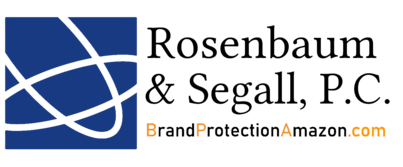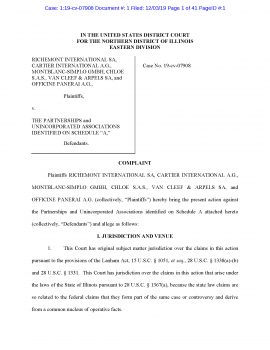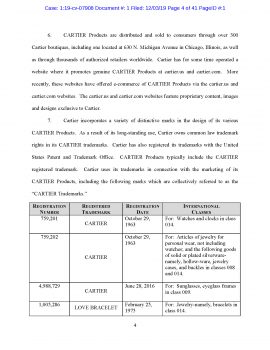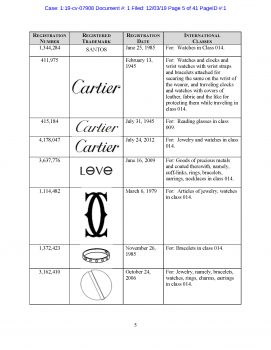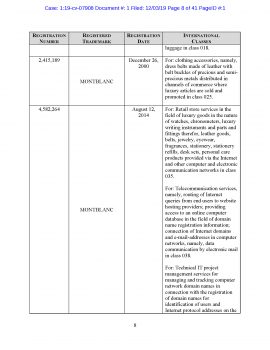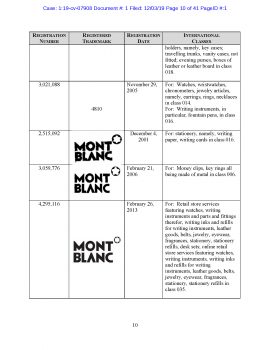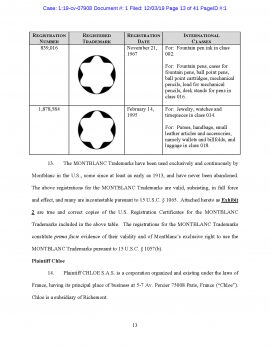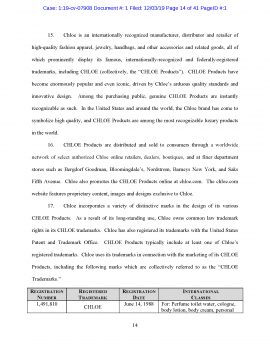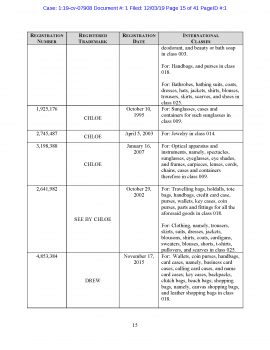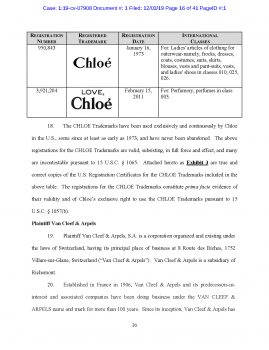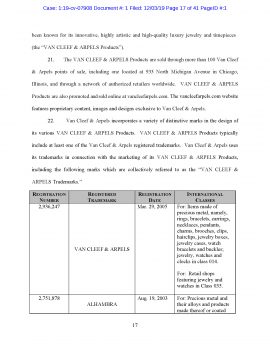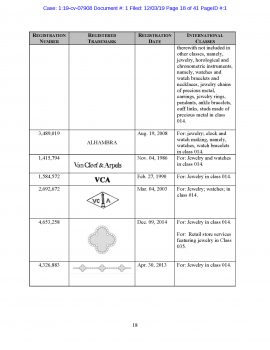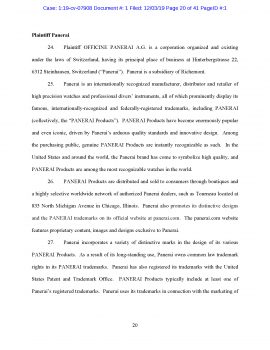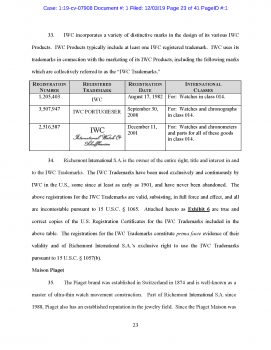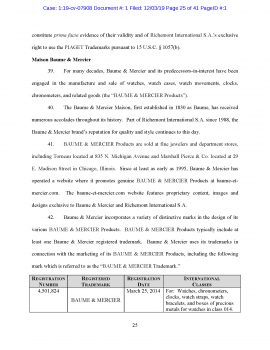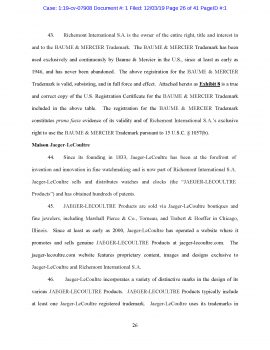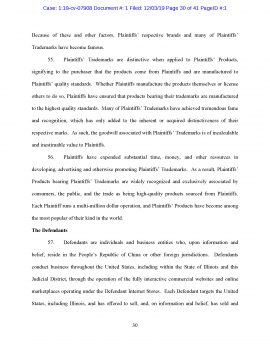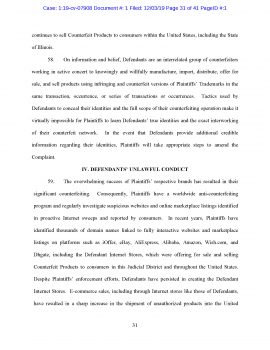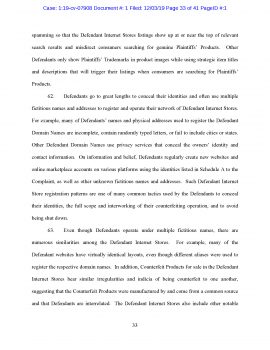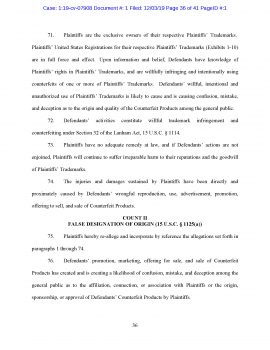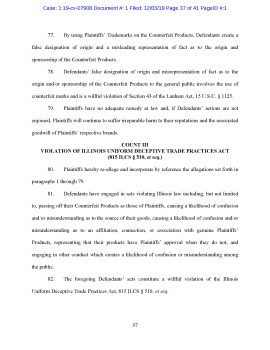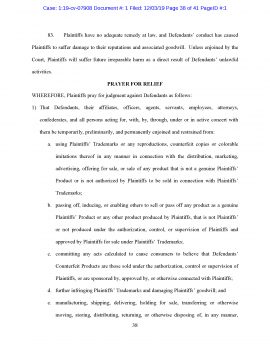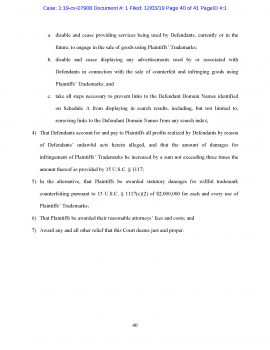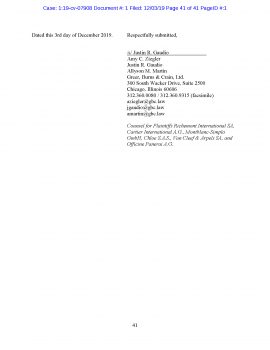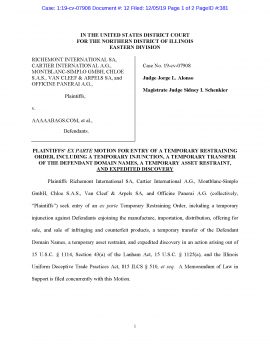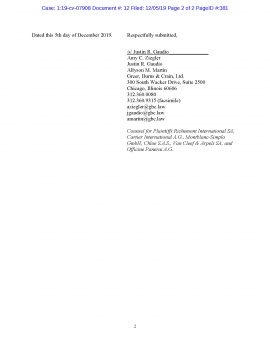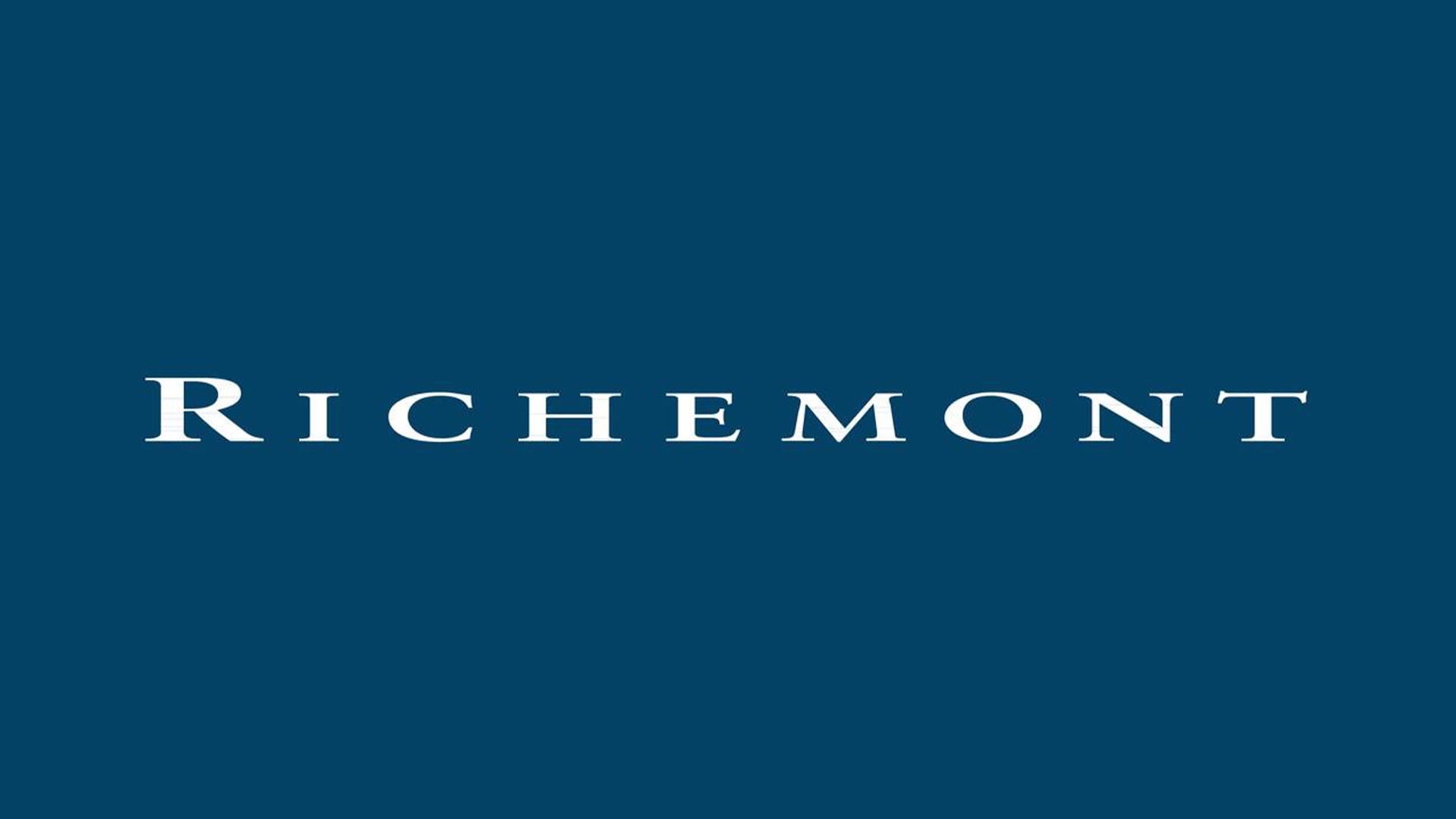
Richemont International SA et al v. The Partnerships and Unincorporated Associations Identified on Schedule “A”
https://youtu.be/geCStMFdCSI
Case: 1:19-cv-07908, Jorge L. Alonso, presiding
UNITED STATES DISTRICT COURT FOR THE NORTHERN DISTRICT OF ILLINOIS EASTERN DIVISION
RICHEMONT INTERNATIONAL SA, CARTIER INTERNATIONAL A.G., MONTBLANC-SIMPLO GMBH, CHLOE S.A.S., VAN CLEEF & ARPELS SA, and OFFICINE PANERAI A.G.,
COMPLAINT: Plaintiffs RICHEMONT INTERNATIONAL SA, CARTIER INTERNATIONAL A.G., MONTBLANC-SIMPLO GMBH, CHLOE S.A.S., VAN CLEEF & ARPELS SA, and OFFICINE PANERAI A.G. (collectively, “Plaintiffs”) hereby bring the present action against the Partnerships and Unincorporated Associations identified on Schedule A attached hereto (collectively, “Defendants”) and allege as follows:
I. JURISDICTION AND VENUE
1. This Court has original subject matter jurisdiction over the claims in this action pursuant to the provisions of the Lanham Act, 15 U.S.C. § 1051, et seq., 28 U.S.C. § 1338(a)-(b) and 28 U.S.C. § 1331. This Court has jurisdiction over the claims in this action that arise under the laws of the State of Illinois pursuant to 28 U.S.C. § 1367(a), because the state law claims are so related to the federal claims that they form part of the same case or controversy and derive from a common nucleus of operative facts.
2. Venue is proper in this Court pursuant to 28 U.S.C. § 1391, and this Court may properly exercise personal jurisdiction over Defendants since each of the Defendants directly targets business activities toward consumers in the United States, including Illinois, through at least the fully interactive, commercial Internet stores operating under the Defendant Domain Names and/or the Online Marketplace Accounts identified in Schedule A attached hereto (collectively, the “Defendant Internet Stores”). Specifically, Defendants are reaching out to do business with Illinois residents by operating one or more commercial, interactive Defendant Internet Stores through which Illinois residents can purchase products using infringing and counterfeit versions of Plaintiffs’ respective trademarks. Each of the Defendants has targeted sales from Illinois residents by operating online stores that offer shipping to the United States, including Illinois, accept payment in U.S. dollars and, on information and belief, has sold products using infringing and counterfeit versions of Plaintiffs’ respective trademarks to residents of Illinois. Each of the Defendants is committing tortious acts in Illinois, is engaging in interstate commerce, and has wrongfully caused Plaintiffs substantial injury in the State of Illinois.
II. INTRODUCTION
3. Plaintiffs are all subsidiaries of Compagnie Financière Richemont SA (“Richemont”), which owns several of the world’s leading companies in the field of luxury goods, with particular strengths in jewelry, luxury watches and writing instruments. This action has been filed by Plaintiffs to combat Internet Store operators who trade upon Plaintiffs’ respective reputations and goodwill by selling and/or offering for sale unauthorized and unlicensed products using infringing and counterfeit versions of Plaintiffs’ trademarks (the “Counterfeit Products”). The Defendants create the Defendant Internet Stores by the hundreds and design them to appear to be selling Plaintiffs’ genuine products, while actually selling Counterfeit Products to unknowing consumers. The Defendant Internet Stores share unique identifiers, such as design elements and similarities of the Counterfeit Products offered for sale, establishing a logical relationship between them and suggesting that Defendants’ counterfeiting operation arises out of the same transaction, occurrence, or series of transactions or occurrences. Defendants attempt to avoid liability by going to great lengths to conceal both their identities and the full scope and interworking of their counterfeiting operation. Plaintiffs are forced to file these actions to combat Defendants’ counterfeiting of their respective registered trademarks, as well as to protect unknowing consumers from purchasing Counterfeit Products over the Internet. Plaintiffs have been and continue to be irreparably damaged through consumer confusion, dilution, and tarnishment of their valuable trademarks as a result of Defendants’ actions and seek injunctive and monetary relief.
III. THE PARTIES
4. Plaintiff CARTIER INTERNATIONAL A.G. is a corporation organized and existing under the laws of Switzerland, having its principal place of business at Hinterbergstrasse 22, 6312 Steinhausen, Switzerland (“Cartier”). Cartier is a subsidiary of Richemont.
5. Cartier is one of the preeminent symbols of luxury in the world. Since at least as early as 1847, Cartier and its predecessors-in-interest and associated companies have been using the CARTIER trademark on and in connection with the advertising and sale of luxury products, including, inter alia, watches, watch buckles, clocks, jewelry, scarves, handbags, eyewear, pens, letter openers, perfumes, and cigarette lighters (collectively, the “CARTIER Products”).
6. CARTIER Products are distributed and sold to consumers through over 300 Cartier boutiques, including one located at 630 N. Michigan Avenue in Chicago, Illinois, as well as through thousands of authorized retailers worldwide. Cartier has for some time operated a website where it promotes genuine CARTIER Products at cartier.us and cartier.com. More recently, these websites have offered e-commerce of CARTIER Products via the cartier.us and cartier.com websites. The cartier.us and cartier.com websites feature proprietary content, images and designs exclusive to Cartier.
7. Cartier incorporates a variety of distinctive marks in the design of its various CARTIER Products. As a result of its long-standing use, Cartier owns common law trademark rights in its CARTIER trademarks. Cartier has also registered its trademarks with the United States Patent and Trademark Office. CARTIER Products typically include the CARTIER registered trademark. Cartier uses its trademarks in connection with the marketing of its CARTIER Products, including the following marks which are collectively referred to as the “CARTIER Trademarks.”
8. The CARTIER Trademarks have been used exclusively and continuously by Cartier and its predecessors-in-interest and associated companies in the U.S., some since at least as early as 1859, and have never been abandoned. The above registrations for the CARTIER Trademarks are valid, subsisting, in full force and effect, and many are incontestable pursuant to 15 U.S.C. § 1065. Attached hereto as Exhibit 1 are true and correct copies of the U.S. Registration Certificates for the CARTIER Trademarks included in the above table. The registrations for the CARTIER Trademarks constitute prima facie evidence of their validity and of Cartier’s exclusive right to use the CARTIER Trademarks pursuant to 15 U.S.C. § 1057(b). Plaintiff Montblanc
9. Plaintiff MONTBLANC-SIMPLO GMBH is a corporation organized and existing under the laws of Germany, having its principal place of business at Hellgrundweg 100 22525 Hamburg, Germany (“Montblanc”). Montblanc is a subsidiary of Richemont.
10. Montblanc is an internationally recognized manufacturer, distributor and retailer of high quality writing instruments, watches and other goods, all of which prominently display its famous, internationally-recognized and federally-registered trademarks, including MONTBLANC (collectively, the “MONTBLANC Products”).
11. MONTBLANC Products are distributed and sold to consumers through a worldwide network of Montblanc boutiques and other tightly-controlled distribution partnerships. In 2011, Montblanc established an e-commerce site in the United States at montblanc.com. Montblanc also launched an e-commerce platform in Europe, covering France, The United Kingdom, and Germany. Sales of MONTBLANC Products via the montblanc.com website represent a significant portion of Montblanc’s business. The montblanc.com website features proprietary content, images and designs exclusive to Montblanc.
12. Montblanc incorporates a variety of distinctive marks in the design of its various MONTBLANC Products. As a result of its long-standing use, Montblanc owns common law trademark rights in its MONTBLANC trademarks. Montblanc has also registered its trademarks with the United States Patent and Trademark Office. MONTBLANC Products typically include at least one of Montblanc’s registered trademarks. Montblanc uses its trademarks in connection with the marketing of its MONTBLANC Products, including the following marks which are collectively referred to as the “MONTBLANC Trademarks.”
13. The MONTBLANC Trademarks have been used exclusively and continuously by Montblanc in the U.S., some since at least as early as 1913, and have never been abandoned. The above registrations for the MONTBLANC Trademarks are valid, subsisting, in full force and effect, and many are incontestable pursuant to 15 U.S.C. § 1065. Attached hereto as Exhibit 2 are true and correct copies of the U.S. Registration Certificates for the MONTBLANC Trademarks included in the above table. The registrations for the MONTBLANC Trademarks constitute prima facie evidence of their validity and of Montblanc’s exclusive right to use the MONTBLANC Trademarks pursuant to 15 U.S.C. § 1057(b).
14. Plaintiff CHLOE S.A.S. is a corporation organized and existing under the laws of France, having its principal place of business at 5-7 Av. Percier 75008 Paris, France (“Chloe”). Chloe is a subsidiary of Richemont.
15. Chloe is an internationally recognized manufacturer, distributor and retailer of high-quality fashion apparel, jewelry, handbags, and other accessories and related goods, all of which prominently display its famous, internationally-recognized and federally-registered trademarks, including CHLOE (collectively, the “CHLOE Products”). CHLOE Products have become enormously popular and even iconic, driven by Chloe’s arduous quality standards and innovative design. Among the purchasing public, genuine CHLOE Products are instantly recognizable as such. In the United States and around the world, the Chloe brand has come to symbolize high quality, and CHLOE Products are among the most recognizable luxury products in the world.
16. CHLOE Products are distributed and sold to consumers through a worldwide network of select authorized Chloe online retailers, dealers, boutiques, and at finer department stores such as Bergdorf Goodman, Bloomingdale’s, Nordstrom, Barneys New York, and Saks Fifth Avenue. Chloe also promotes the CHLOE Products online at chloe.com. The chloe.com website features proprietary content, images and designs exclusive to Chloe.
17. Chloe incorporates a variety of distinctive marks in the design of its various CHLOE Products. As a result of its long-standing use, Chloe owns common law trademark rights in its CHLOE trademarks. Chloe has also registered its trademarks with the United States Patent and Trademark Office. CHLOE Products typically include at least one of Chloe’s registered trademarks. Chloe uses its trademarks in connection with the marketing of its CHLOE Products, including the following marks which are collectively referred to as the “CHLOE Trademarks.”
18. The CHLOE Trademarks have been used exclusively and continuously by Chloe in the U.S., some since at least as early as 1973, and have never been abandoned. The above registrations for the CHLOE Trademarks are valid, subsisting, in full force and effect, and many are incontestable pursuant to 15 U.S.C. § 1065. Attached hereto as Exhibit 3 are true and correct copies of the U.S. Registration Certificates for the CHLOE Trademarks included in the above table. The registrations for the CHLOE Trademarks constitute prima facie evidence of their validity and of Chloe’s exclusive right to use the CHLOE Trademarks pursuant to 15 U.S.C. § 1057(b).
19. Plaintiff Van Cleef & Arpels, S.A. is a corporation organized and existing under the laws of Switzerland, having its principal place of business at 8 Route des Biches, 1752 Villars-sur-Glane, Switzerland (“Van Cleef & Arpels”). Van Cleef & Arpels is a subsidiary of Richemont.
20. Established in France in 1906, Van Cleef & Arpels and its predecessors-in-interest and associated companies have been doing business under the VAN CLEEF & ARPELS name and mark for more than 100 years. Since its inception, Van Cleef & Arpels has been known for its innovative, highly artistic and high-quality luxury jewelry and timepieces (the “VAN CLEEF & ARPELS Products”).
21. The VAN CLEEF & ARPELS Products are sold through more than 100 Van Cleef & Arpels points of sale, including one located at 933 North Michigan Avenue in Chicago, Illinois, and through a network of authorized retailers worldwide. VAN CLEEF & ARPELS Products are also promoted and sold online at vancleefarpels.com. The vancleefarpels.com website features proprietary content, images and designs exclusive to Van Cleef & Arpels.
22. Van Cleef & Arpels incorporates a variety of distinctive marks in the design of its various VAN CLEEF & ARPELS Products. VAN CLEEF & ARPELS Products typically include at least one of the Van Cleef & Arpels registered trademarks. Van Cleef & Arpels uses its trademarks in connection with the marketing of its VAN CLEEF & ARPELS Products, including the following marks which are collectively referred to as the “VAN CLEEF & ARPELS Trademarks.”
23. Van Cleef & Arpels is the owner of the entire right, title and interest in and to the VAN CLEEF & ARPELS Trademarks. The VAN CLEEF & ARPELS Trademarks have been used exclusively and continuously by Van Cleef & Arpels in the U.S., some since at least as early as 1939, and have never been abandoned. The above registrations for the VAN CLEEF & ARPELS Trademarks are valid, subsisting, in full force and effect, and many are incontestable pursuant to 15 U.S.C. § 1065. Attached hereto as Exhibit 4 are true and correct copies of the U.S. Registration Certificates for the VAN CLEEF & ARPELS Trademarks included in the above table. The registrations for the VAN CLEEF & ARPELS Trademarks constitute prima facie evidence of their validity and of Van Cleef & Arpels’ exclusive right to use the VAN
CLEEF & ARPELS Trademarks pursuant to 15 U.S.C. § 1057(b).
24. Plaintiff OFFICINE PANERAI A.G. is a corporation organized and existing under the laws of Switzerland, having its principal place of business at Hinterbergstrasse 22, 6312 Steinhausen, Switzerland (“Panerai”). Panerai is a subsidiary of Richemont.
25. Panerai is an internationally recognized manufacturer, distributor and retailer of high precision watches and professional divers’ instruments, all of which prominently display its famous, internationally-recognized and federally-registered trademarks, including PANERAI (collectively, the “PANERAI Products”). PANERAI Products have become enormously popular and even iconic, driven by Panerai’s arduous quality standards and innovative design. Among the purchasing public, genuine PANERAI Products are instantly recognizable as such. In the United States and around the world, the Panerai brand has come to symbolize high quality, and PANERAI Products are among the most recognizable watches in the world.
26. PANERAI Products are distributed and sold to consumers through boutiques and a highly selective worldwide network of authorized Panerai dealers, such as Tourneau located at 835 North Michigan Avenue in Chicago, Illinois. Panerai also promotes its distinctive designs and the PANERAI trademarks on its official website at panerai.com. The panerai.com website features proprietary content, images and designs exclusive to Panerai.
27. Panerai incorporates a variety of distinctive marks in the design of its various PANERAI Products. As a result of its long-standing use, Panerai owns common law trademark rights in its PANERAI trademarks. Panerai has also registered its trademarks with the United States Patent and Trademark Office. PANERAI Products typically include at least one of Panerai’s registered trademarks. Panerai uses its trademarks in connection with the marketing of its PANERAI Products, including the following marks which are collectively referred to as the “PANERAI Trademarks.”
28. The PANERAI Trademarks have been used exclusively and continuously by Panerai and/or its predecessors-in-interest and associated companies in the U.S., some since at least as early as 2000, and have never been abandoned. The above registrations for the PANERAI Trademarks are valid, subsisting, in full force and effect, and many are incontestable pursuant to 15 U.S.C. § 1065. Attached hereto as Exhibit 5 are true and correct copies of the U.S. Registration Certificates for the PANERAI Trademarks included in the above table. The registrations for the PANERAI Trademarks constitute prima facie evidence of their validity and of Panerai’s exclusive right to use the PANERAI Trademarks pursuant to 15 U.S.C. § 1057(b). Plaintiff Richemont International S.A.
29. Plaintiff RICHEMONT INTERNATIONAL S.A. is a corporation organized and existing under the laws of Switzerland, having its principal place of business at 10 Route des Biches, 1752 Villars-sur-Glane, Switzerland (“Richemont International S.A.”). Richemont International S.A. is a subsidiary of Richemont.
30. Richemont International S.A.’s Maisons or house brands include several of the most prestigious names in the luxury timepiece and jewelry industry: IWC Schaffhausen, Piaget, Baume & Mercier, Jaeger-LeCoultre, and Vacheron Constantin.
Maison IWC
31. IWC was established nearly 150 years ago in Schaffhausen, Switzerland by the American Florentine Ariosto Jones, a watchmaker from Boston, Massachusetts. His initial aim: to produce high-quality pocket watches for the American market. Since then, the IWC Swiss watch manufacturers have been creating masterpieces of haute horlogerie that combine precision engineering with exclusive design (“IWC Products”). IWC was acquired by Richemont International S.A. in 2000.
32. IWC Products are sold worldwide at fine jewelers and department stores, including Torneau located at 835 N. Michigan Avenue in Chicago. IWC Products are also promoted online at iwc.com. The iwc.com website features proprietary content, images and designs exclusive to IWC and Richemont International S.A.
33. IWC incorporates a variety of distinctive marks in the design of its various IWC Products. IWC Products typically include at least one IWC registered trademark. IWC uses its trademarks in connection with the marketing of its IWC Products, including the following marks which are collectively referred to as the “IWC Trademarks.”
34. Richemont International S.A. is the owner of the entire right, title and interest in and to the IWC Trademarks. The IWC Trademarks have been used exclusively and continuously by IWC in the U.S., some since at least as early as 1901, and have never been abandoned. The above registrations for the IWC Trademarks are valid, subsisting, in full force and effect, and all are incontestable pursuant to 15 U.S.C. § 1065. Attached hereto as Exhibit 6 are true and correct copies of the U.S. Registration Certificates for the IWC Trademarks included in the above table. The registrations for the IWC Trademarks constitute prima facie evidence of their validity and of Richemont International S.A.’s exclusive right to use the IWC Trademarks pursuant to 15 U.S.C. § 1057(b).
35. The Piaget brand was established in Switzerland in 1874 and is well-known as a master of ultra-thin watch movement construction. Part of Richemont International S.A. since 1988, Piaget also has an established reputation in the jewelry field. Since the Piaget Maison was established, Piaget has sold and distributed watches, watch parts and watch movements, clocks, chronometers, jewelry and other luxury goods (the “PIAGET Products”).
36. PIAGET Products are sold in Piaget boutiques and through other authorized retailers, including Trabert & Hoeffer in Chicago, Illinois. Since at least as early as 1997, Piaget has operated a website where it promotes and sells genuine PIAGET Products at piaget.com. The piaget.com website features proprietary content, images and designs exclusive to Piaget and Richemont International S.A.
37. Piaget incorporates a variety of distinctive marks in the design of its various PIAGET Products. PIAGET Products typically include at least one Piaget registered trademark. Piaget uses its trademarks in connection with the marketing of its PIAGET Products, including the following marks which are collectively referred to as the “PIAGET Trademarks.”
38. Richemont International S.A. is the owner of the entire right, title and interest in and to the PIAGET Trademarks. The PIAGET Trademarks have been used exclusively and continuously by Piaget in the U.S., some since at least as early as 1959, and have never been abandoned. The above registrations for the PIAGET Trademarks are valid, subsisting, in full force and effect, and all are incontestable pursuant to 15 U.S.C. § 1065. Attached hereto as Exhibit 7 are true and correct copies of the U.S. Registration Certificates for the PIAGET Trademarks included in the above table. The registrations for the PIAGET Trademarks constitute prima facie evidence of their validity and of Richemont International S.A.’s exclusive right to use the PIAGET Trademarks pursuant to 15 U.S.C. § 1057(b).
39. For many decades, Baume & Mercier and its predecessors-in-interest have been engaged in the manufacture and sale of watches, watch cases, watch movements, clocks, chronometers, and related goods (the “BAUME & MERCIER Products”).
40. The Baume & Mercier Maison, first established in 1830 as Baume, has received numerous accolades throughout its history. Part of Richemont International S.A. since 1988, the Baume & Mercier brand’s reputation for quality and style continues to this day.
41. BAUME & MERCIER Products are sold at fine jewelers and department stores, including Torneau located at 835 N. Michigan Avenue and Marshall Pierce & Co. located at 29 E. Madison Street in Chicago, Illinois. Since at least as early as 1995, Baume & Mercier has operated a website where it promotes genuine BAUME & MERCIER Products at baume-et-mercier.com. The baume-et-mercier.com website features proprietary content, images and designs exclusive to Baume & Mercier and Richemont International S.A.
42. Baume & Mercier incorporates a variety of distinctive marks in the design of its various BAUME & MERCIER Products. BAUME & MERCIER Products typically include at least one Baume & Mercier registered trademark. Baume & Mercier uses its trademarks in connection with the marketing of its BAUME & MERCIER Products, including the following mark which is referred to as the “BAUME & MERCIER Trademark.”
43. Richemont International S.A. is the owner of the entire right, title and interest in and to the BAUME & MERCIER Trademark. The BAUME & MERCIER Trademark has been used exclusively and continuously by Baume & Mercier in the U.S., since at least as early as 1946, and has never been abandoned. The above registration for the BAUME & MERCIER Trademark is valid, subsisting, and in full force and effect. Attached hereto as Exhibit 8 is a true and correct copy of the U.S. Registration Certificate for the BAUME & MERCIER Trademark included in the above table. The registration for the BAUME & MERCIER Trademark constitutes prima facie evidence of its validity and of Richemont International S.A.’s exclusive right to use the BAUME & MERCIER Trademark pursuant to 15 U.S.C. § 1057(b).
44. Since its founding in 1833, Jaeger-LeCoultre has been at the forefront of invention and innovation in fine watchmaking and is now part of Richemont International S.A. Jaeger-LeCoultre sells and distributes watches and clocks (the “JAEGER-LECOULTRE Products”) and has obtained hundreds of patents.
45. JAEGER-LECOULTRE Products are sold via Jaeger-LeCoultre boutiques and fine jewelers, including Marshall Pierce & Co., Torneau, and Trabert & Hoeffer in Chicago, Illinois. Since at least as early as 2000, Jaeger-LeCoultre has operated a website where it promotes and sells genuine JAEGER-LECOULTRE Products at jaeger-lecoultre.com. The jaeger-lecoultre.com website features proprietary content, images and designs exclusive to Jaeger-LeCoultre and Richemont International S.A.
46. Jaeger-LeCoultre incorporates a variety of distinctive marks in the design of its various JAEGER-LECOULTRE Products. JAEGER-LECOULTRE Products typically include at least one Jaeger-LeCoultre registered trademark. Jaeger-LeCoultre uses its trademarks in connection with the marketing of its JAEGER-LECOULTRE Products, including the following marks which are collectively referred to as the “JAEGER-LECOULTRE Trademarks.”
47. Richemont International S.A. is the owner of the entire right, title and interest in and to the JAEGER-LECOULTRE Trademarks. The JAEGER-LECOULTRE Trademarks have been used exclusively and continuously by Jaeger-LeCoultre in the U.S., some since at least as early as 1968, and have never been abandoned. The above registrations for the JAEGER-LECOULTRE Trademarks are valid, subsisting, in full force and effect, and both are incontestable pursuant to 15 U.S.C. § 1065. Attached hereto as Exhibit 9 are true and correct copies of the U.S. Registration Certificates for the JAEGER-LECOULTRE Trademarks included in the above table. The registrations for the JAEGER-LECOULTRE Trademarks constitute prima facie evidence of their validity and of Richemont International S.A.’s exclusive right to use the JAEGER-LECOULTRE Trademarks pursuant to 15 U.S.C. § 1057(b).
48. Since its founding in 1755, Vacheron Constantin has been involved in the sale and distribution of watches, chronometers, clocks, jewelry, and related goods (the “VACHERON CONSTANTIN Products”). Vacheron Constantin became part of Richemont International S.A. in 1996.
49. VACHERON CONSTANTIN Products are sold through Vacheron Constantin boutiques and a network of authorized retailers, including Trabert & Hoeffer in Chicago, Illinois. VACHERON CONSTANTIN Products are also promoted online at vacheron-constantin.com. The vacheron-constantin.com website features proprietary content, images and designs exclusive to Vacheron Constantin and Richemont International S.A.
50. Vacheron Constantin incorporates a variety of distinctive marks in the design of its various VACHERON CONSTANTIN Products. VACHERON CONSTANTIN Products typically include at least one of the Vacheron Constantin registered trademarks. Vacheron Constantin uses its trademarks in connection with the marketing of its VACHERON CONSTANTIN Products, including the following marks which are collectively referred to as the “VACHERON CONSTANTIN Trademarks.”
51. Richemont International S.A. is the owner of the entire right, title and interest in and to the VACHERON CONSTANTIN Trademarks. The VACHERON CONSTANTIN Trademarks have been used exclusively and continuously by Vacheron Constantin in the U.S. since at least as early as 2006 and have never been abandoned. The above registrations for the VACHERON CONSTANTIN Trademarks are valid, subsisting, in full force and effect, and some are incontestable pursuant to 15 U.S.C. § 1065. Attached hereto as Exhibit 10 are true and 28 correct copies of the U.S. Registration Certificates for the VACHERON CONSTANTIN Trademarks included in the above table. The registrations for the VACHERON CONSTANTIN Trademarks constitute prima facie evidence of their validity and of Richemont International S.A.’s exclusive right to use the VACHERON CONSTANTIN Trademarks pursuant to 15 U.S.C. § 1057(b).
Plaintiffs’ Trademarks and Plaintiffs’ Products
52. The CARTIER Trademarks, MONTBLANC Trademarks, CHLOE Trademarks, VAN CLEEF & ARPELS Trademarks, PANERAI Trademarks, IWC Trademarks, PIAGET Trademarks, BAUME & MERCIER Trademark, JAEGER-LECOULTRE Trademarks, and VACHERON CONSTANTIN Trademarks are collectively referred to herein as “Plaintiffs’ Trademarks.”
53. The CARTIER Products, MONTBLANC Products, CHLOE Products, VAN CLEEF & ARPELS Products, PANERAI Products, IWC Products, PIAGET Products, BAUME & MERCIER Products, JAEGER-LECOULTRE Products, and VACHERON CONSTANTIN Products are collectively referred to herein as “Plaintiffs’ Products.”
54. Plaintiffs’ Trademarks are exclusive to Plaintiffs, and are displayed extensively on Plaintiffs’ Products and in Plaintiffs’ marketing and promotional materials. Plaintiffs’ Products have long been among the most popular luxury products in the world and have been extensively promoted and advertised at great expense. In fact, Plaintiffs have expended millions of dollars annually in advertising, promoting and marketing featuring their respective Plaintiffs’ Trademarks. Plaintiffs’ Products have also been the subject of extensive unsolicited publicity resulting from their high-quality, innovative designs and renown as desired luxury items. Because of these and other factors, Plaintiffs’ respective brands and many of Plaintiffs’ Trademarks have become famous.
55. Plaintiffs’ Trademarks are distinctive when applied to Plaintiffs’ Products, signifying to the purchaser that the products come from Plaintiffs and are manufactured to Plaintiffs’ quality standards. Whether Plaintiffs manufacture the products themselves or license others to do so, Plaintiffs have ensured that products bearing their trademarks are manufactured to the highest quality standards. Many of Plaintiffs’ Trademarks have achieved tremendous fame and recognition, which has only added to the inherent or acquired distinctiveness of their respective marks. As such, the goodwill associated with Plaintiffs’ Trademarks is of incalculable and inestimable value to Plaintiffs.
56. Plaintiffs have expended substantial time, money, and other resources in developing, advertising and otherwise promoting Plaintiffs’ Trademarks. As a result, Plaintiffs’ Products bearing Plaintiffs’ Trademarks are widely recognized and exclusively associated by consumers, the public, and the trade as being high-quality products sourced from Plaintiffs. Each Plaintiff runs a multi-million dollar operation, and Plaintiffs’ Products have become among the most popular of their kind in the world.
The Defendants
57. Defendants are individuals and business entities who, upon information and belief, reside in the People’s Republic of China or other foreign jurisdictions. Defendants conduct business throughout the United States, including within the State of Illinois and this Judicial District, through the operation of the fully interactive commercial websites and online marketplaces operating under the Defendant Internet Stores. Each Defendant targets the United States, including Illinois, and has offered to sell, and, on information and belief, has sold and continues to sell Counterfeit Products to consumers within the United States, including the State of Illinois.
58. On information and belief, Defendants are an interrelated group of counterfeiters working in active concert to knowingly and willfully manufacture, import, distribute, offer for sale, and sell products using infringing and counterfeit versions of Plaintiffs’ Trademarks in the same transaction, occurrence, or series of transactions or occurrences. Tactics used by Defendants to conceal their identities and the full scope of their counterfeiting operation make it virtually impossible for Plaintiffs to learn Defendants’ true identities and the exact interworking of their counterfeit network. In the event that Defendants provide additional credible information regarding their identities, Plaintiffs will take appropriate steps to amend the Complaint.
IV. DEFENDANTS’ UNLAWFUL CONDUCT
59. The overwhelming success of Plaintiffs’ respective brands has resulted in their significant counterfeiting. Consequently, Plaintiffs have a worldwide anti-counterfeiting program and regularly investigate suspicious websites and online marketplace listings identified in proactive Internet sweeps and reported by consumers. In recent years, Plaintiffs have identified thousands of domain names linked to fully interactive websites and marketplace listings on platforms such as iOffer, eBay, AliExpress, Alibaba, Amazon, Wish.com, and Dhgate, including the Defendant Internet Stores, which were offering for sale and selling Counterfeit Products to consumers in this Judicial District and throughout the United States. Despite Plaintiffs’ enforcement efforts, Defendants have persisted in creating the Defendant Internet Stores. E-commerce sales, including through Internet stores like those of Defendants, have resulted in a sharp increase in the shipment of unauthorized products into the United States. Exhibit 11, Excerpts from Fiscal Year 2018 U.S. Customs and Border Protection (“CBP”) Intellectual Property Seizure Statistics Report. Over 90% of all CBP intellectual property seizures were smaller international mail and express shipments (as opposed to large shipping containers). Id. Over 85% of CBP seizures originated from mainland China and Hong Kong. Id. Counterfeit and pirated products account for billions in economic losses, resulting in tens of thousands of lost jobs for legitimate businesses and broader economic losses, including lost tax revenue.
60. Defendants facilitate sales by designing the Defendant Internet Stores so that they appear to unknowing consumers to be authorized online retailers, outlet stores, or wholesalers. Many of the Defendant Internet Stores look sophisticated and accept payment in U.S. dollars via credit cards, Alipay, Amazon Pay, Western Union, and/or PayPal. The Defendant Internet Stores often include content and design elements that make it very difficult for consumers to distinguish such counterfeit sites from an authorized website. Many Defendants further perpetuate the illusion of legitimacy by offering customer service and using indicia of authenticity and security that consumers have come to associate with authorized retailers, including the Visa®, MasterCard®, and/or PayPal® logos. Plaintiffs have not licensed or authorized Defendants to use any of the Plaintiffs’ Trademarks, and none of the Defendants are authorized retailers of genuine Plaintiffs’ Products.
61. Many Defendants also deceive unknowing consumers by using Plaintiffs’ Trademarks without authorization within the content, text, and/or meta tags of their websites in order to attract various search engines crawling the Internet looking for websites relevant to consumer searches for Plaintiffs’ Products. Additionally, upon information and belief, Defendants use other unauthorized search engine optimization (SEO) tactics and social media spamming so that the Defendant Internet Stores listings show up at or near the top of relevant search results and misdirect consumers searching for genuine Plaintiffs’ Products. Other Defendants only show Plaintiffs’ Trademarks in product images while using strategic item titles and descriptions that will trigger their listings when consumers are searching for Plaintiffs’ Products.
62. Defendants go to great lengths to conceal their identities and often use multiple fictitious names and addresses to register and operate their network of Defendant Internet Stores. For example, many of Defendants’ names and physical addresses used to register the Defendant Domain Names are incomplete, contain randomly typed letters, or fail to include cities or states. Other Defendant Domain Names use privacy services that conceal the owners’ identity and contact information. On information and belief, Defendants regularly create new websites and online marketplace accounts on various platforms using the identities listed in Schedule A to the Complaint, as well as other unknown fictitious names and addresses. Such Defendant Internet Store registration patterns are one of many common tactics used by the Defendants to conceal their identities, the full scope and interworking of their counterfeiting operation, and to avoid being shut down.
63. Even though Defendants operate under multiple fictitious names, there are numerous similarities among the Defendant Internet Stores. For example, many of the Defendant websites have virtually identical layouts, even though different aliases were used to register the respective domain names. In addition, Counterfeit Products for sale in the Defendant Internet Stores bear similar irregularities and indicia of being counterfeit to one another, suggesting that the Counterfeit Products were manufactured by and come from a common source and that Defendants are interrelated. The Defendant Internet Stores also include other notable common features, including use of the same domain name registration patterns, shopping cart platforms, accepted payment methods, check-out methods, meta data, illegitimate SEO tactics, HTML user-defined variables, domain redirection, lack of contact information, identically or similarly priced items and volume sales discounts, the same incorrect grammar and misspellings, similar hosting services, similar name servers, and the use of the same text and images.
64. In addition to operating under multiple fictitious names, Defendants in this case and defendants in other similar cases against online counterfeiters use a variety of other common tactics to evade enforcement efforts. For example, counterfeiters like Defendants will often register new domain names or online marketplace accounts under new aliases once they receive notice of a lawsuit. Counterfeiters also often move website hosting to rogue servers located outside the United States once notice of a lawsuit is received. Rogue servers are notorious for ignoring take down demands sent by brand owners. Counterfeiters also typically ship products in small quantities via international mail to minimize detection by U.S. Customs and Border Protection.
65. Further, counterfeiters such as Defendants typically operate multiple credit card merchant accounts and PayPal accounts behind layers of payment gateways so that they can continue operation in spite of Plaintiffs’ enforcement efforts. On information and belief, Defendants maintain off-shore bank accounts and regularly move funds from their PayPal accounts or other financial accounts to off-shore bank accounts outside the jurisdiction of this Court. Indeed, analysis of PayPal transaction logs from previous similar cases indicates that off-shore counterfeiters regularly move funds from U.S.-based PayPal accounts to off-shore bank accounts outside the jurisdiction of this Court.
66. Defendants, without any authorization or license from Plaintiffs, have knowingly and willfully used and continue to use Plaintiffs’ Trademarks in connection with the advertisement, distribution, offering for sale, and sale of Counterfeit Products into the United States and Illinois over the Internet. Each Defendant Internet Store offers shipping to the United States, including Illinois, and, on information and belief, each Defendant has sold Counterfeit Products into the United States, including Illinois.
67. Defendants’ use of Plaintiffs’ Trademarks in connection with the advertising, distribution, offering for sale, and sale of Counterfeit Products, including the sale of Counterfeit Products into the United States, including Illinois, is likely to cause and has caused confusion, mistake, and deception by and among consumers and is irreparably harming Plaintiffs.
COUNT I – TRADEMARK INFRINGEMENT AND COUNTERFEITING (15 U.S.C. § 1114)
68. Plaintiffs hereby re-allege and incorporate by reference the allegations set forth in paragraphs 1 through 67.
69. This is a trademark infringement action against Defendants based on their unauthorized use in commerce of counterfeit imitations of the federally registered Plaintiffs’ Trademarks in connection with the sale, offering for sale, distribution, and/or advertising of infringing goods. Plaintiffs’ Trademarks are highly distinctive marks. Consumers have come to expect the highest quality from Plaintiffs’ Products offered, sold or marketed under Plaintiffs’ Trademarks.
70. Defendants have sold, offered to sell, marketed, distributed, and advertised, and are still selling, offering to sell, marketing, distributing, and advertising products using counterfeit reproductions of Plaintiffs’ Trademarks without Plaintiffs’ permission.
71. Plaintiffs are the exclusive owners of their respective Plaintiffs’ Trademarks. Plaintiffs’ United States Registrations for their respective Plaintiffs’ Trademarks (Exhibits 1-10) are in full force and effect. Upon information and belief, Defendants have knowledge of Plaintiffs’ rights in Plaintiffs’ Trademarks, and are willfully infringing and intentionally using counterfeits of one or more of Plaintiffs’ Trademarks. Defendants’ willful, intentional and unauthorized use of Plaintiffs’ Trademarks is likely to cause and is causing confusion, mistake, and deception as to the origin and quality of the Counterfeit Products among the general public.
72. Defendants’ activities constitute willful trademark infringement and counterfeiting under Section 32 of the Lanham Act, 15 U.S.C. § 1114.
73. Plaintiffs have no adequate remedy at law, and if Defendants’ actions are not enjoined, Plaintiffs will continue to suffer irreparable harm to their reputations and the goodwill of Plaintiffs’ Trademarks.
74. The injuries and damages sustained by Plaintiffs have been directly and proximately caused by Defendants’ wrongful reproduction, use, advertisement, promotion, offering to sell, and sale of Counterfeit Products.
COUNT II – FALSE DESIGNATION OF ORIGIN (15 U.S.C. § 1125(a))
75. Plaintiffs hereby re-allege and incorporate by reference the allegations set forth in paragraphs 1 through 74.
76. Defendants’ promotion, marketing, offering for sale, and sale of Counterfeit Products has created and is creating a likelihood of confusion, mistake, and deception among the general public as to the affiliation, connection, or association with Plaintiffs or the origin, sponsorship, or approval of Defendants’ Counterfeit Products by Plaintiffs.
77. By using Plaintiffs’ Trademarks on the Counterfeit Products, Defendants create a false designation of origin and a misleading representation of fact as to the origin and sponsorship of the Counterfeit Products.
78. Defendants’ false designation of origin and misrepresentation of fact as to the origin and/or sponsorship of the Counterfeit Products to the general public involves the use of counterfeit marks and is a willful violation of Section 43 of the Lanham Act, 15 U.S.C. § 1125.
79. Plaintiffs have no adequate remedy at law and, if Defendants’ actions are not enjoined, Plaintiffs will continue to suffer irreparable harm to their reputations and the associated goodwill of Plaintiffs’ respective brands.
COUNT III – VIOLATION OF ILLINOIS UNIFORM DECEPTIVE TRADE PRACTICES ACT (815 ILCS § 510, et seq.)
80. Plaintiffs hereby re-allege and incorporate by reference the allegations set forth in paragraphs 1 through 79.
81. Defendants have engaged in acts violating Illinois law including, but not limited to, passing off their Counterfeit Products as those of Plaintiffs, causing a likelihood of confusion and/or misunderstanding as to the source of their goods, causing a likelihood of confusion and/or misunderstanding as to an affiliation, connection, or association with genuine Plaintiffs’ Products, representing that their products have Plaintiffs’ approval when they do not, and engaging in other conduct which creates a likelihood of confusion or misunderstanding among the public.
82. The foregoing Defendants’ acts constitute a willful violation of the Illinois Uniform Deceptive Trade Practices Act, 815 ILCS § 510, et seq.
83. Plaintiffs have no adequate remedy at law, and Defendants’ conduct has caused Plaintiffs to suffer damage to their reputations and associated goodwill. Unless enjoined by the Court, Plaintiffs will suffer future irreparable harm as a direct result of Defendants’ unlawful activities.
PRAYER FOR RELIEF
WHEREFORE, Plaintiffs pray for judgment against Defendants as follows:
1) That Defendants, their affiliates, officers, agents, servants, employees, attorneys, confederates, and all persons acting for, with, by, through, under or in active concert with them be temporarily, preliminarily, and permanently enjoined and restrained from:
a. using Plaintiffs’ Trademarks or any reproductions, counterfeit copies or colorable imitations thereof in any manner in connection with the distribution, marketing, advertising, offering for sale, or sale of any product that is not a genuine Plaintiffs’ Product or is not authorized by Plaintiffs to be sold in connection with Plaintiffs’ Trademarks;
b. passing off, inducing, or enabling others to sell or pass off any product as a genuine Plaintiffs’ Product or any other product produced by Plaintiffs, that is not Plaintiffs’ or not produced under the authorization, control, or supervision of Plaintiffs and approved by Plaintiffs for sale under Plaintiffs’ Trademarks;
c. committing any acts calculated to cause consumers to believe that Defendants’ Counterfeit Products are those sold under the authorization, control or supervision of Plaintiffs, or are sponsored by, approved by, or otherwise connected with Plaintiffs;
d. further infringing Plaintiffs’ Trademarks and damaging Plaintiffs’ goodwill; and
e. manufacturing, shipping, delivering, holding for sale, transferring or otherwise moving, storing, distributing, returning, or otherwise disposing of, in any manner, products or inventory not manufactured by or for Plaintiffs, nor authorized by Plaintiffs to be sold or offered for sale, and which bear any of Plaintiffs’ trademarks, including the Plaintiffs’ Trademarks, or any reproductions, counterfeit copies or colorable imitations thereof;
2) Entry of an Order that, at Plaintiffs’ choosing, the registrant of the Defendant Domain Names shall be changed from the current registrant to Plaintiffs, and that the domain name registries for the Defendant Domain Names, including, but not limited to, VeriSign, Inc., Neustar, Inc., Afilias Limited, CentralNic, Nominet, and the Public Interest Registry, shall unlock and change the registrar of record for the Defendant Domain Names to a registrar of Plaintiffs’ selection, and that the domain name registrars, including, but not limited to, GoDaddy Operating Company, LLC (“GoDaddy”), Name.com, PDR LTD. d/b/a PublicDomainRegistry.com (“PDR”), and Namecheap Inc. (“Namecheap”), shall take any steps necessary to transfer the Defendant Domain Names to a registrar account of Plaintiffs’ selection; or that the same domain name registries shall disable the Defendant Domain Names and make them inactive and untransferable;
3) Entry of an Order that, upon Plaintiffs’ request, those in privity with Defendants and those with notice of the injunction, including, without limitation, any online marketplace platforms such as iOffer, eBay, AliExpress, Alibaba, Amazon, Wish.com, and Dhgate, web hosts, sponsored search engine or ad-word providers, credit cards, banks, merchant account providers, third party processors and other payment processing service providers, Internet search engines such as Google, Bing and Yahoo, and domain name registrars, including, but not limited to, GoDaddy, Name.com, PDR, and Namecheap, (collectively, the “Third Party Providers”) shall:
a. disable and cease providing services being used by Defendants, currently or in the future, to engage in the sale of goods using Plaintiffs’ Trademarks;
b. disable and cease displaying any advertisements used by or associated with Defendants in connection with the sale of counterfeit and infringing goods using Plaintiffs’ Trademarks; and
c. take all steps necessary to prevent links to the Defendant Domain Names identified on Schedule A from displaying in search results, including, but not limited to, removing links to the Defendant Domain Names from any search index;
4) That Defendants account for and pay to Plaintiffs all profits realized by Defendants by reason of Defendants’ unlawful acts herein alleged, and that the amount of damages for infringement of Plaintiffs’ Trademarks be increased by a sum not exceeding three times the amount thereof as provided by 15 U.S.C. § 1117;
5) In the alternative, that Plaintiffs be awarded statutory damages for willful trademark counterfeiting pursuant to 15 U.S.C. § 1117(c)(2) of $2,000,000 for each and every use of Plaintiffs’ Trademarks;
6) That Plaintiffs be awarded their reasonable attorneys’ fees and costs; and
7) Award any and all other relief that this Court deems just and proper.
